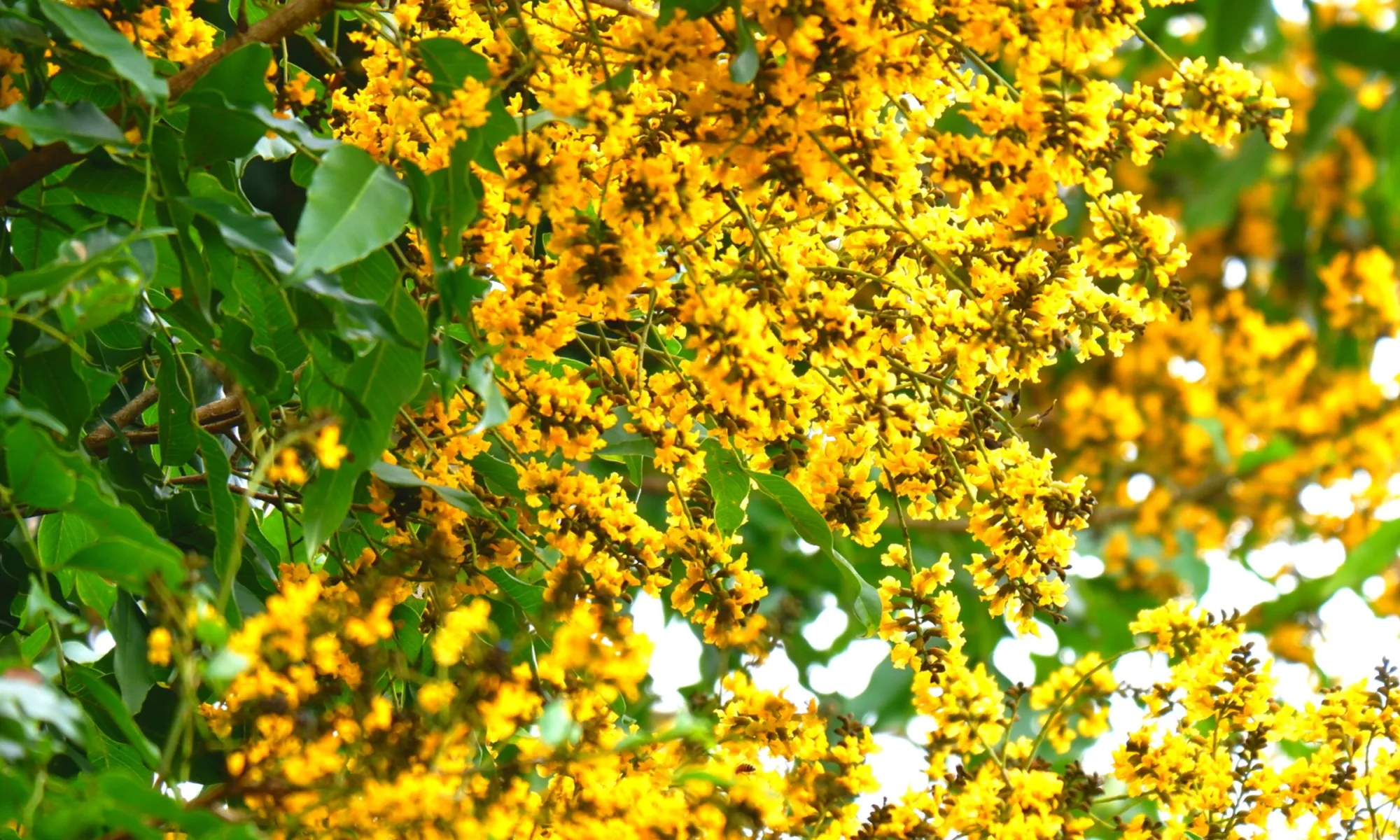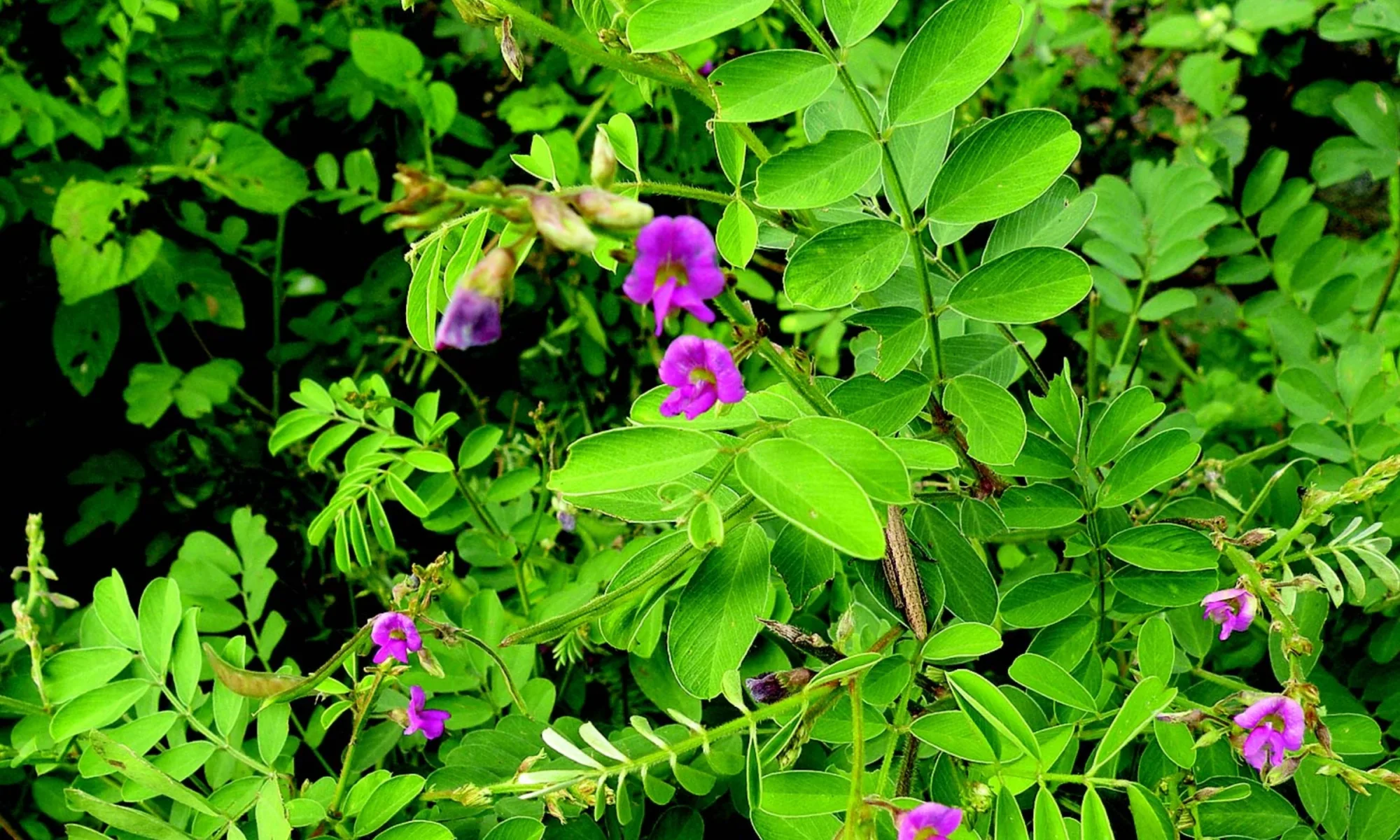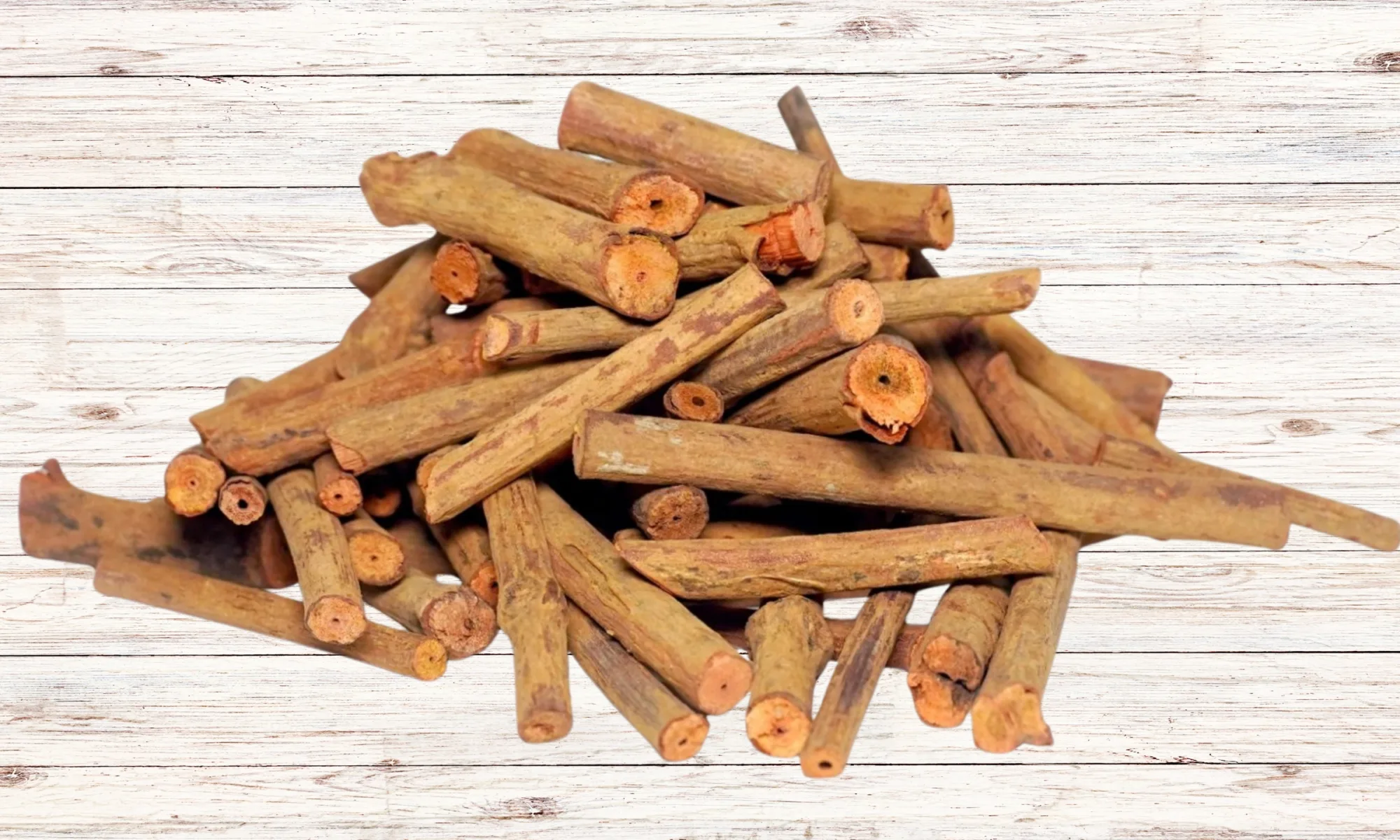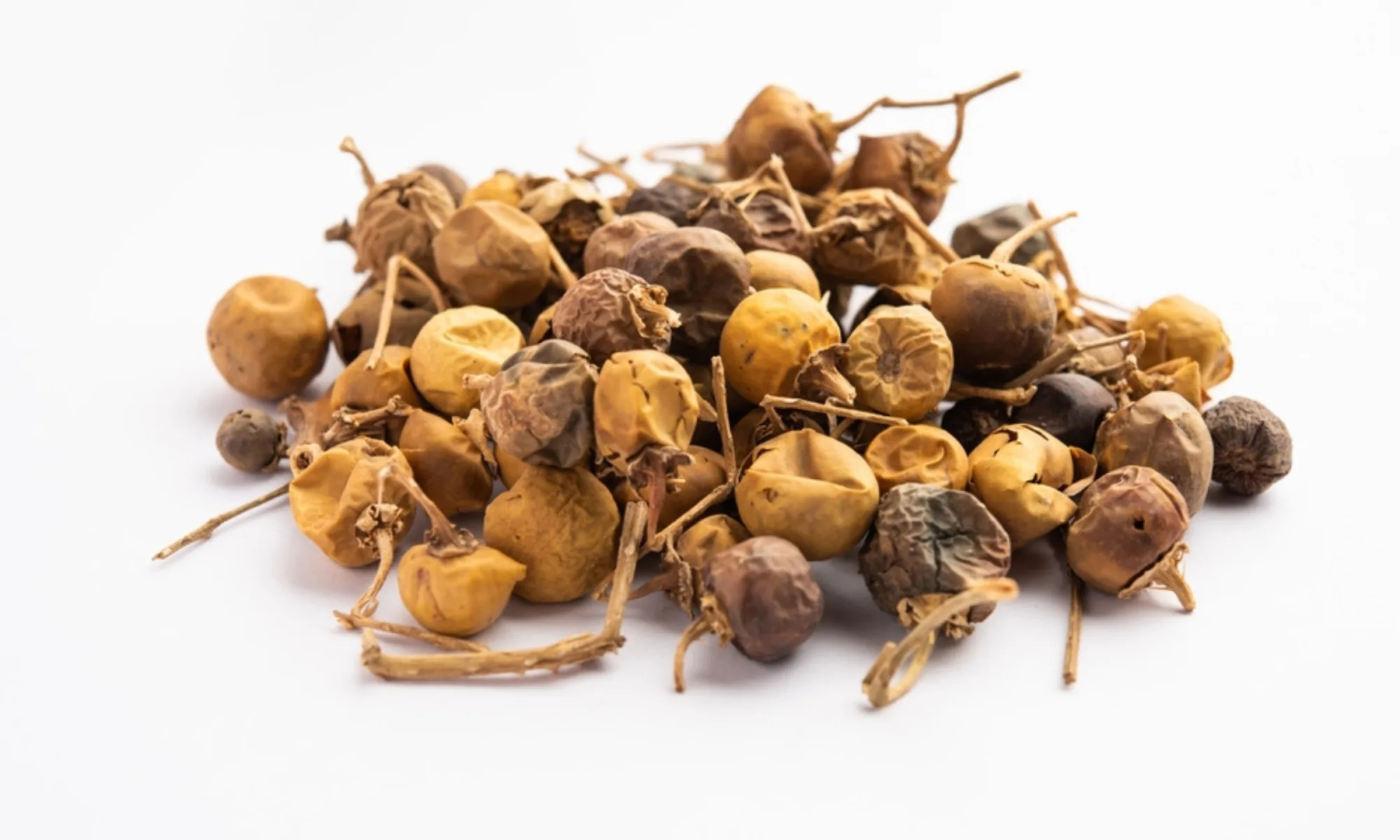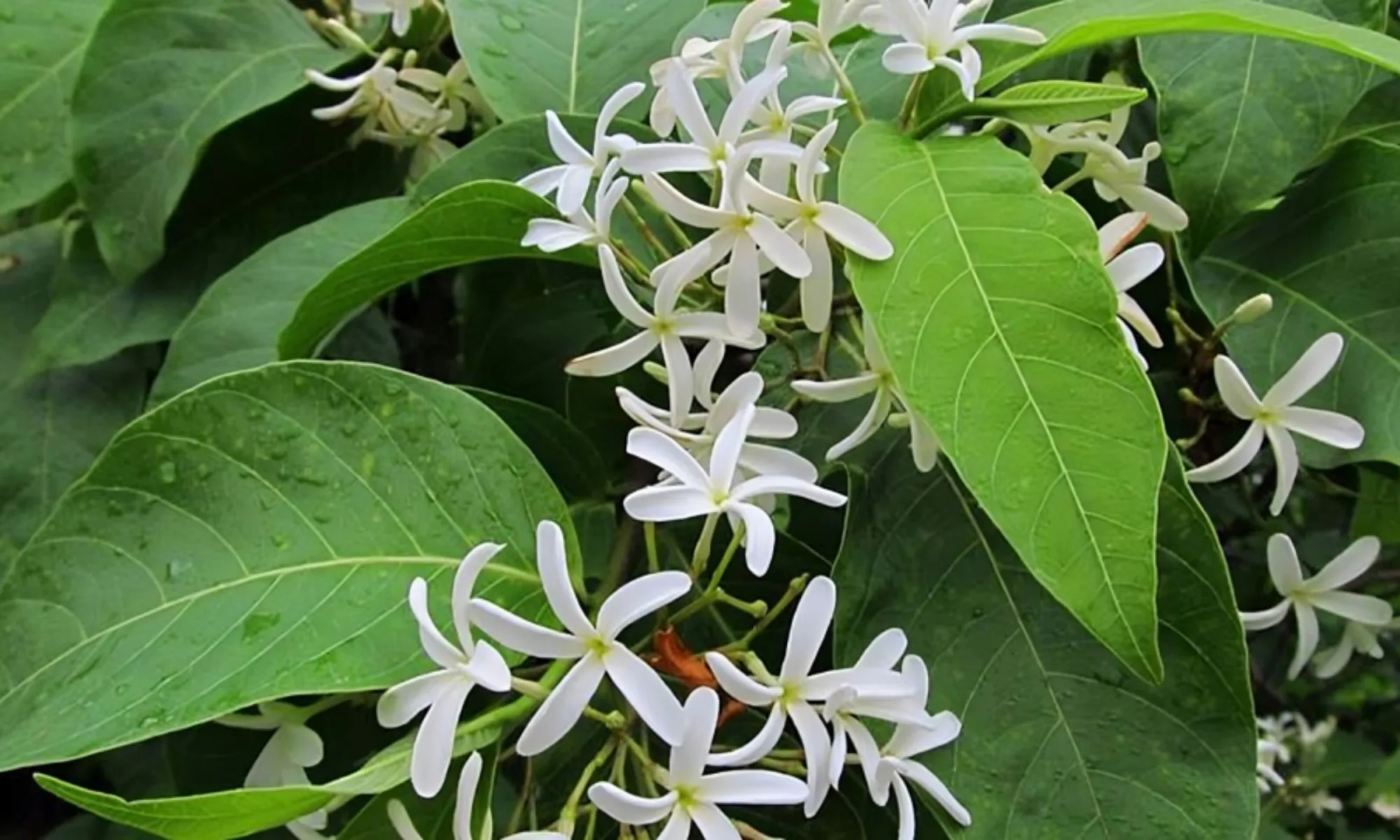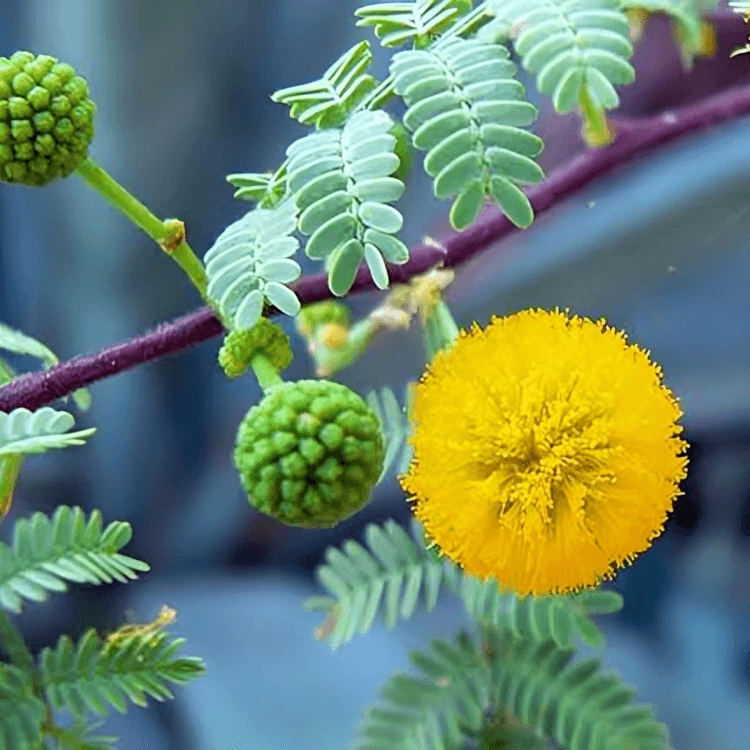
Pterocarpus marsupium, commonly known as Bijsar or Indian Kino Tree, is a deciduous tree native to India and parts of Sri Lanka and Nepal. It belongs to the Fabaceae family and is widely recognized in Ayurveda for its potent antidiabetic, anti-inflammatory, and antioxidant properties. The heartwood is especially valued for its use in managing diabetes mellitus, while the bark, leaves, and gum are also used for various traditional remedies.
Pterocarpus marsupium Scientific Name
- Kingdom: Plantae
- Phylum: Angiosperms
- Class: Eudicots
- Order: Fabales
- Family: Fabaceae
- Genus: Pterocarpus
- Species: Pterocarpus marsupium Roxb.
Pterocarpus marsupium Common Name
- English: Indian Kino Tree, Malabar Kino
- Sanskrit: Vijaysar, Asana
- Hindi: Bijasar, Bijasar
- Gujarati: Bavasar
- Tamil: Vengai
- Telugu: Vegisa
- Marathi: Bibla
- Malayalam: Venga
Pterocarpus marsupium Uses
- Antidiabetic Action – The heartwood is traditionally used in the form of wooden tumblers or decoctions to reduce blood sugar levels in Type 2 diabetes.
- Cardiovascular Health – Contains flavonoids that strengthen blood vessels and improve circulation, Used to reduce cholesterol levels and improve lipid profiles.
- Anti-inflammatory and Analgesic – The bark and heartwood extract have been used to reduce swelling and pain, especially in rheumatic conditions.
- Wound Healing – Gum and bark paste are applied to chronic ulcers and wounds for faster healing.
Phytochemical Constituents
Pterocarpus marsupium is known for its high content of medicinally active constituents, particularly in its heartwood. Major phytochemicals include:
- Flavonoids: Marsupsin, Pterosupin, Liquiritigenin
- Triterpenoids: Betulinic acid
- Polyphenols: Epicatechin
- Gums and Tannins: Kinotannic acid
- Lignans and Steroids: Sitosterol
References
Ayurvedic Pharmacopoeia of India (API), Govt. of India, Vol. 2, Part 1.
Nadkarni, K.M. (1976). Indian Materia Medica, Vol. 1. Bombay: Popular Prakashan.
Chopra, R.N., Nayar, S.L., & Chopra, I.C. (1956). Glossary of Indian Medicinal Plants. CSIR, New Delhi.
Grover, J.K., Yadav, S., & Vats, V. (2002). “Medicinal plants of India with anti-diabetic potential.” Journal of Ethnopharmacology, 81(1), 81–100.
Rathi, B., Bodhankar, S., & Baheti, A. (2004). “Evaluation of antidiabetic and antioxidant efficacy of Pterocarpus marsupium Roxb.” Indian Journal of Pharmacology, 36(4), 238-242.
Warrier, P.K., Nambiar, V.P.K., & Ramankutty, C. (1995). Indian Medicinal Plants: A Compendium of 500 Species, Vol. 4. Orient Longman Ltd.
Indian Herbal Pharmacopoeia, (2002). Published by Indian Drug Manufacturers’ Association (IDMA), Mumbai.

Sarpankha (Tephrosia purpurea) is a perennial herb or small shrub commonly used in traditional Ayurvedic medicine. It belongs to the Fabaceae family and is known for its liver-protective, anti-inflammatory, and wound-healing properties. It is widely distributed throughout India and is often found in dry regions. Sarpankha has long been used as a blood purifier and to treat skin and liver conditions.
Tephrosia purpurea Scientific Name
- Kingdom: Plantae
- Phylum: Angiosperms
- Class: Eudicots
- Order: Fabales
- Family: Fabaceae
- Genus: Tephrosia
- Species: Tephrosia purpurea
Tephrosia purpurea Common Name
- English: Purple Tephrosia, Wild Indigo
- Sanskrit: Sarpankha, Sharpunkha
- Hindi: Sarphoka, Sharpunkha
- Tamil: Kolunchi
- Telugu: Vempali
- Kannada: Kolasige
- Bengali: Sarpankho
Traditional and Medicinal Uses
- Liver Health – Traditionally used to treat hepatitis, liver cirrhosis, and enlarged liver, Acts as a hepatoprotective agent, aiding in liver detoxification and bile secretion.
- Skin Disorders – Beneficial in treating eczema, dermatitis, and wounds, The paste of leaves is applied externally for itching and swelling.
- Anti-inflammatory and Analgesic – Used to relieve pain, inflammation, and swelling in conditions like rheumatism.
- Blood Purification – Used as a Raktashodhak (blood purifier) in Ayurvedic texts.
- Respiratory Disorders – Used to alleviate symptoms of asthma and chronic bronchitis.
Phytochemical Constituents
References
The Ayurvedic Pharmacopoeia of India, Part I, Volume II, Govt. of India, Ministry of AYUSH.
Kirtikar, K.R., & Basu, B.D. (1935). Indian Medicinal Plants, Vol. II. Bishen Singh Mahendra Pal Singh, Dehradun.
Nadkarni, K.M. (1976). Indian Materia Medica, Vol. I. Bombay Popular Prakashan.
Chopra, R.N., Nayar, S.L., & Chopra, I.C. (1956). Glossary of Indian Medicinal Plants. CSIR, New Delhi.
Ahmed, F., & Urooj, A. (2010). “Hepatoprotective effects of Tephrosia purpurea on carbon tetrachloride-induced liver damage in rats.” Iranian Journal of Pharmacology and Therapeutics, 9(2), 45–49.
Rathi, B., Bodhankar, S.L., & Baheti, A.M. (2006). “Evaluation of aqueous leaf extract of Tephrosia purpurea for hepatoprotective activity in rats.” Indian Journal of Pharmacology, 38(1), 25–28.
European Medicines Agency. Herbal Monograph on Tephrosia purpurea. Committee on Herbal Medicinal Products (HMPC), 2020.

Manjistha (Rubia cordifolia), commonly known as Indian Madder, is a perennial, climbing herb belonging to the Rubiaceae family. It is extensively used in Ayurvedic medicine for blood purification, detoxification, and treating various skin disorders. The main portions used for therapeutic purposes are the red-colored roots and stems. It has hepatoprotective, anti-inflammatory, antioxidant, and anti-acne qualities.
MANJISTHA Scientific Name
- Kingdom: Plantae
- Phylum: Tracheophyta
- Class: Magnoliopsida
- Order: Gentianales
- Family: Rubiaceae
- Genus: Rubia
- Species: Rubia cordifolia
MANJISTHA Common Name
- English: Indian Madder
- Sanskrit: Manjistha, Raktanga, Samanga
- Hindi: Manjith
- Tamil: Manditti
- Telugu: Tamravalli
- Malayalam: Manjatti
- Kannada: Manjishte
- Bengali: Manjith
MANJISTHA Uses
- Blood Purifier – Supports detoxification of blood and liver, Used to manage chronic skin conditions like eczema, psoriasis, and acne.
- Anti-inflammatory & Wound Healing – Helps reduce inflammation, swelling, and supports wound healing.
- Reproductive & Urinary System – Useful in managing menstrual disorders and urinary tract infections.
- Antioxidant Support – Protects tissues from oxidative stress, delays aging processes.
Phytochemical Constituents
Rubia cordifolia is rich in a wide range of bioactive compounds responsible for its therapeutic effects:
- Anthraquinones: Rubiadin, Purpurin, Alizarin, Munjistin
- Naphthoquinones: Deoxyerythrolaccin
- Iridoids: Asperulosidic acid, Geniposidic acid
- Triterpenoids: Rubiprasins A and B
- Others: Tannins, Saponins, Glycosides, Resins
References
Ayurvedic Pharmacopoeia of India, Part I, Vol. I, Govt. of India, Ministry of AYUSH.
Sharma, P. V. (2001). Dravyaguna Vijnana (Materia Medica-Vegetable Drugs), Vol. 2. Chaukhambha Bharati Academy.
Kaur, S., & Michael, H. (2014). “Pharmacognostic and phytochemical studies on Rubia cordifolia L. (Indian Madder).” International Journal of Pharmacy and Pharmaceutical Sciences, 6(5), 631-636.
Singla, A. K., & Pathak, K. (1990). “Anti-inflammatory studies on extracts of Rubia cordifolia L.” Indian Journal of Pharmacology, 22(1), 9–11.
European Medicines Agency. (2022). Community Herbal Monograph on Rubia cordifolia L., radix.
Bhatt, A., & Pandey, A. (2020). “A comprehensive review on Rubia cordifolia L.: A potential medicinal plant.” Journal of Ethnopharmacology, 253, 112624.
Nadkarni, K. M. (2007). Indian Materia Medica, Vol. 1. Popular Prakashan.

Kantkari (Solanum xanthocarpum) is a spiny, perennial herb or small shrub found in dry plains, often used in Ayurvedic, Siddha, and Unani systems of medicine. It is one of the Dashamoola (ten roots) herbs in Ayurveda and is traditionally known for its efficacy in treating respiratory ailments, urinary disorders, fever, and inflammatory conditions. The entire plant, including fruits, roots, and seeds, is considered medicinal.
Scientific Classification
- Kingdom: Plantae
- Phylum: Angiosperms
- Class: Eudicots
- Order: Solanales
- Family: Solanaceae
- Genus: Solanum
- Species: Solanum xanthocarpum
Common Names
- English: Yellow-berried Nightshade, Kantkari
- Sanskrit: Kantkari, Brihati
- Hindi: Kantakari, Bhatkataiya
- Gujarati: Kantoli
- Tamil: Kandankattiri
- Telugu: Nelatigeru
- Marathi: Ringani
Traditional and Medicinal Uses
- Urinary Tract and Kidney Health – Traditionally used for urinary retention, dysuria, and kidney stones.
- Anti-inflammatory and Analgesic – Reduces joint inflammation, pain, and swelling in conditions like arthritis and gout.
- Antimicrobial Action – Effective against bacterial and fungal infections, Helps in managing skin diseases, wounds, and ulcers.
- Digestive and Liver Support – Aids in digestion, relieves gas and colic, Used in hepatoprotective formulations.
Phytochemical Constituents
References
Ayurvedic Pharmacopoeia of India (API), Part I, Vol. I, Govt. of India.
Nadkarni, K.M. (1976). Indian Materia Medica, Vol. 1. Popular Prakashan.
Sharma, P.V. (1996). Dravyaguna Vijnana (Materia Medica – Vegetable Drugs). Chaukhamba Bharati Academy.
Warrier, P.K., Nambiar, V.P.K., & Ramankutty, C. (1995). Indian Medicinal Plants: A Compendium of 500 Species, Vol. 5. Orient Longman.
Meena, A.K., et al. (2010). “Medicinal uses of Solanum xanthocarpum – A review.” Der Pharmacia Lettre, 2(4): 403–407.
Patil, M.V., Patil, D.A. (2007). “Ethnomedicinal Plants of Nasik District, Maharashtra.” Ethnobotanical Leaflets, 11: 1–5.
Chopra, R.N., Nayar, S.L., & Chopra, I.C. (1956). Glossary of Indian Medicinal Plants. CSIR, New Delhi.

Kutaj (Holarrhena pubescens) is a deciduous shrub or small tree commonly found in India and other tropical parts of Asia. It is well-known for having strong astringent, antibacterial, and anti-diarrheal effects. Kutaj has long been used to treat skin conditions, irritable bowel syndrome (IBS), chronic diarrhea, and dysentery in the Ayurvedic, Unani, and Siddha medical systems. The most often utilized medicinal elements are the seeds and bark.
Holarrhena pubescens Scientific Name
- Kingdom: Plantae
- Phylum: Angiosperms
- Class: Eudicots
- Order: Gentianales
- Family: Apocynaceae
- Genus: Holarrhena
- Species: Holarrhena pubescens (Synonym: Holarrhena antidysenterica)
Holarrhena pubescens Common Name
- English: Kutaj, Ivory Tree, Conessi Tree
- Sanskrit: Kutaja, Kalinga, Indrayava
- Hindi: Kutaj, Kuda
- Gujarati: Kuda
- Marathi: Kuda
- Tamil: Veppalai
- Telugu: Kodaga
- Bengali: Kurchi
- Malayalam: Kutinja
Holarrhena pubescens Uses
- Digestive and Intestinal Disorders – Powerful anti-diarrheal and antidysenteric, Used in grahani (IBS) and chronic amoebic dysentery.Its bark decoction is given in diarrhea and intestinal infections.
- Skin Diseases – Used in treating eczema, psoriasis, fungal infections, and boils, Has antibacterial and antifungal properties.
- Anthelmintic Action – Seeds are used to eliminate intestinal worms.
- Antipyretic and Anti-inflammatory – Used to manage fever and inflammatory conditions.
Phytochemical Constituents
References
Ayurvedic Pharmacopoeia of India, Govt. of India, Part I, Vol. I, II, and III.
Nadkarni, K.M. (2002). Indian Materia Medica, Vol 1. Bombay Popular Prakashan.
Sharma, P.V. (2005). Dravyaguna Vigyan, Vol 2. Chaukhamba Bharti Academy.
Kirtikar, K.R., & Basu, B.D. (2008). Indian Medicinal Plants, Vol. 3. Lalit Mohan Basu Publications.
Chatterjee, A. & Pakrashi, S.C. (1994). The Treatise on Indian Medicinal Plants, Vol. 3, CSIR Publications.
Dwivedi, S., & Jauhari, R. (2010). “Holarrhena antidysenterica: Pharmacognostic and Pharmacological Profile.” International Journal of Pharmaceutical Sciences Review and Research, 4(2), 39–44.
European Medicines Agency. Herbal monograph on Holarrhena pubescens bark.
Meena, H., et al. (2010). “Review on Holarrhena antidysenterica.” Journal of Pharmacognosy and Phytochemistry, 2(3), 01–05.

The moderate-sized, deciduous Khadir (Acacia catechu Willd.) tree is indigenous to regions of Southeast Asia and the Indian subcontinent. Its astringent, anti-inflammatory, antibacterial, and blood-purifying qualities make it valuable in both traditional medicine and Ayurveda. Its heartwood extract, known as Khadirasara or Katha, is especially noted for therapeutic use in skin disorders, dental care, and digestive health.
KHADIR Scientific Name
- Kingdom: Plantae
- Phylum: Tracheophyta
- Class: Magnoliopsida
- Order: Fabales
- Family: Fabaceae
- Genus: Acacia
- Species: Acacia catechu (Willd.)
Acacia catechu Common Name
- English: Catechu, Black Cutch Tree
- Sanskrit: Khadira
- Hindi: Khair
- Gujarati: Khakhra
- Tamil: Karungali
- Telugu: Konda Tumma
- Malayalam: Karingali
- Kannada: Kaggali
Acacia catechu Uses
- Skin Disorders – Khadir is a prime herb in treating eczema, psoriasis, acne, leprosy, and other skin ailments due to its blood-purifying and antimicrobial effects.
- Dental & Oral Health – The decoction of bark or use of Katha (extract) is used as a mouthwash to treat gingivitis, sore gums, mouth ulcers, and toothache.
- Digestive System – Acts as an astringent and digestive tonic, beneficial in diarrhea, dysentery, and ulcerative colitis.
- Blood Purification – Considered a Rakta Shodhak (blood purifier) in Ayurveda, especially useful in chronic skin conditions and general detoxification.
- Anti-inflammatory & Wound Healing – Applied externally for wound healing and reducing inflammation, especially in hemorrhoids and ulcers.
- Anti-diabetic Support – Helps in managing elevated blood sugar levels and mitigating complications related to diabetes.
Phytochemical Constituents
Khadir is rich in polyphenols, flavonoids, tannins, and catechins, which contribute to its therapeutic properties:
- Tannins: Catechin, Epicatechin (up to 30–60%)
- Flavonoids: Quercetin, Kaempferol
- Phenolic Acids: Gallic acid, Protocatechuic acid
- Other Constituents: Mucilage, Resin, Gum, and Coloring Matter (Cutch)
References
Ayurvedic Pharmacopoeia of India (API), Part I, Vol. III. Govt. of India, Ministry of AYUSH.
Sharangdhar Samhita, Chapter on Skin Disorders.
Kaur, G., Hamid, H., Ali, A., Alam, M.S., & Athar, M. (2004). “Antiinflammatory evaluation of alcoholic extract of Acacia catechu Willd. and its fractions in animal models.” Journal of Ethnopharmacology, 92(2–3), 231–239.
Kumar, A., & Sati, B. (2012). “Phytochemical and pharmacological profile of Acacia catechu – An overview.” International Journal of Pharmaceutical and Biological Archives, 3(5), 1062–1068.
Nadkarni, K.M. (1976). Indian Materia Medica, Vol. I. Bombay: Popular Prakashan.
Chopra, R.N., Nayar, S.L., & Chopra, I.C. (1956). Glossary of Indian Medicinal Plants. CSIR, New Delhi.
European Pharmacopoeia, 10th Edition. Council of Europe.

Katuki (Picrorhiza kurroa) is a small perennial herb native to the Himalayan region, known for its bitter rhizomes with potent hepatoprotective and anti-inflammatory properties. It has been widely utilized to treat fevers, respiratory conditions, and liver diseases in Ayurveda and other traditional systems. Katuki thrives at high altitudes (2700–4500 m) and is considered a critically endangered medicinal herb due to overharvesting.
Picrorhiza kurroa Scientific Name
- Kingdom: Plantae
- Phylum: Angiosperms
- Class: Eudicots
- Order: Lamiales
- Family: Plantaginaceae
- Genus: Picrorhiza
- Species: Picrorhiza kurroa Royle ex Benth.
Picrorhiza kurroa Common Name
- English: Katuki, Picrorhiza
- Sanskrit: Katuki, Tikta
- Hindi: Katuka, Kutki
- Gujarati: Kutaki
- Bengali: Kutki
- Tamil: Kadugurohini
- Malayalam: Katavelyam
- Telugu: Katukaroha
Picrorhiza kurroa Uses
- Liver and Gallbladder Disorders – Acts as a potent hepatoprotective and cholagogue, Useful in managing hepatitis, jaundice, and liver cirrhosis.
- Metabolic and Digestive Health – Stimulates bile secretion, promoting digestion, Helps treat anorexia, dyspepsia, and hyperacidity.
- Respiratory Conditions – Beneficial in treating asthma, bronchitis, and chronic coughs.
- Antipyretic and Anti-inflammatory – Reduces intermittent fevers, particularly those associated with malaria or chronic infections, Provides systemic anti-inflammatory support.
- Immune Support and Detoxification – Acts as an immunomodulator and supports detoxification in chronic conditions.
Katuki’s efficacy is attributed to its diverse phytochemical profile, especially iridoid glycosides:
- Iridoid Glycosides: Kutkin (mixture of Picroside I & Kutkoside), Picroside I, II
- Phenolic Compounds: Apocynin, Vanillic acid, Caffeic acid
- Flavonoids: Luteolin, Apigenin
- Glycosides: Androsin
- Others: Cucurbitacins (in some varieties), Sterols
References
Ayurvedic Pharmacopoeia of India, Govt. of India, Part I, Vol. III, Ministry of AYUSH.
Khare, C.P. (2007). Indian Medicinal Plants: An Illustrated Dictionary. Springer.
Sharma, P.V. (1996). Dravyaguna Vigyan Vol. II. Chaukhamba Bharati Academy.
Sharma, V., & Pandey, D. (2010). “Pharmacological and therapeutic activity of Picrorhiza kurroa: A review.” International Journal of Research in Pharmaceutical Sciences, 1(1), 1–8.
Dwivedi, S., & Agarwal, M.P. (1994). “Picrorhiza kurroa Royle ex Benth—A review.” Indian Drugs, 31(6), 273–276.
The Wealth of India (1992). Raw Materials Series Vol. 7: Ka to Li, CSIR, New Delhi.
European Medicines Agency (EMA) (2015). Assessment Report on Picrorhiza kurroa Rhizome, Committee on Herbal Medicinal Products.

Sallaki (Boswellia serrata) is a medium-sized deciduous tree native to India, known for its gum resin called Indian Frankincense or Salai guggul. This gum-resin is widely used in Ayurveda and Unani systems of medicine to treat inflammatory conditions, especially arthritis, joint pain, and respiratory disorders. Its powerful anti-inflammatory action is mainly due to active compounds known as boswellic acids.
Guggal Scientific Name
- Kingdom: Plantae
- Phylum: Angiosperms
- Class: Eudicots
- Order: Sapindales
- Family: Burseraceae
- Genus: Boswellia
- Species: Boswellia serrata
Boswellia serrata Common Name
- English: Indian Frankincense, Salai
- Sanskrit: Shallaki, Gajabhaksha
- Hindi: Salai guggul
- Gujarati: Guggal
- Tamil: Parangikattam
- Telugu: Phirangi-samadram
- Kannada: Phirangimalligida
- Marathi: Dhup, Salai
Boswellia serrata Uses
- Respiratory Disorders – Acts as a bronchodilator, used in asthma and chronic bronchitis.
- Anti-inflammatory Agent – Boswellic acids inhibit 5-lipoxygenase, an enzyme responsible for inflammation, Comparable efficacy to NSAIDs, without gastric irritation.
- Skin and Wound Healing – Topical application of the gum helps in wound healing and skin infections.
References
Ayurvedic Pharmacopoeia of India (API), Part I, Vol. III. Government of India, Ministry of AYUSH.
Indian Materia Medica, Dr. K.M. Nadkarni, Popular Prakashan.
Ammon, H.P.T. (2006). “Boswellic acids in chronic inflammatory diseases.” Planta Medica, 72(12), 1100–1116.
Siddiqui, M.Z. (2011). “Boswellia serrata, a potential antiinflammatory agent: an overview.” Indian Journal of Pharmaceutical Sciences, 73(3), 255–261.
European Medicines Agency (EMA) – Assessment Report on Boswellia serrata.
Sivarajan, V.V., & Balachandran, I. (1994). Ayurvedic Drugs and Their Plant Sources. Oxford & IBH Publishing.
Sharma, P.C., Yelne, M.B., & Dennis, T.J. (2002). Database on Medicinal Plants Used in Ayurveda, Vol. 3. CCRAS, Ministry of AYUSH.

